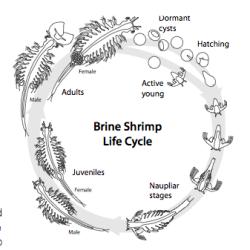Source Institutions
Source Institutions
Add to list Go to activity

What is the optimal environment for hatching brine shrimp? Using a scaffold, learners design and conduct experiments testing the effect of a single abiotic factor on brine shrimp cyst hatch rate. Pool results from the group to determine the optimal environment for hatching these resilient organisms.
- 10 to 30 minutes
- 1 to 7 days
- Over $20 per group of students
- Ages 11 - 18
- Activity, Experiment/Lab Activity, Lesson/Lesson Plan
- English
Quick Guide
Materials List (per group of students)
- Copies of lab sheets
- 1 g brine shrimp cysts hydrated in salt solution
- Small petri dishes
- Soft, white, absorbent paper towels (uniform embossing works best)
- Small pipettes or droppers
- 3% salt solution
- Microscopes or hand lenses
- Petri dishes or other shallow, wide containers, test tubes, graduated cylinders
- UV light source (UV light box or goggle sterilizer)
- Incubator, refrigerator
- Acidic and basic solutions (vinegar, bleach, etc.)
- Aluminum foil
- Non-iodized salt
- Pollutants (household pesticide and herbicide, fertilizer, etc.)
- Aquarium aerator, flexible tubing
Subjects
-
Life Sciences
-
Diversity of Life
- Animals
-
Ecology
- Ecosystems
- Human Impact
-
Evolution
- Mechanisms of Evolution
-
Diversity of Life
-
Mathematics
-
Data Analysis and Probability
- Data Analysis
- Data Collection
- Data Representation
-
Measurement
- Rate
-
Data Analysis and Probability
-
The Nature of Science
-
The Scientific Process
- Conducting Investigations
- Gathering Data
- Formulating Explanations
- Communicating Results
-
The Scientific Process
Informal Categories
- Animals
- Nature and Environment
Audience
To use this activity, learners need to:
- see
- read
- touch
Learning styles supported:
- Involves teamwork and communication skills
- Involves hands-on or lab activities
Other
This resource is part of:
Access Rights:
- Free access
By:
- Teach.Genetics, University of Utah
Source Collection
- Teach.Genetics
Rights:
- All rights reserved, University of Utah, 2009
Funding Sources:
- Westminster College
- Utah's WIRED (Workforce Innovation In Regional Economic Development) program
